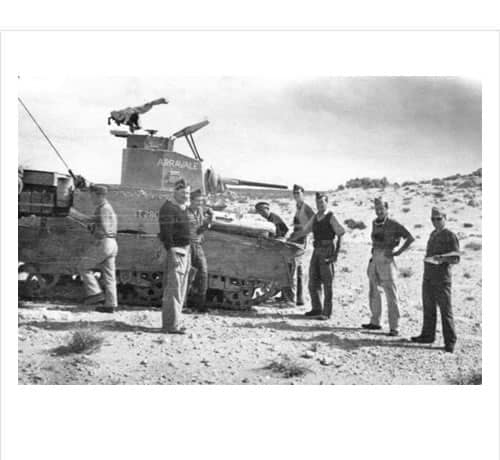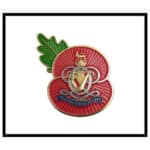October 1942 saw the first amalgamation of the 4th and 8th Hussars due to heavy losses in September to form The 4th/8th Hussars. They would be commanded by the Commanding Officer of 4th Queen’s Own Hussars, Lt Col RCH Kidd through the battle and the rapid pursuit in November.
23 October 1942.
The regiment advanced to the concentration area.
General Horrocks’ assault plan for 13 Corps was to make four gaps in the British minefields the night before the battle was due to start. Through this, the advance guard would move up to the German minefields, codenamed ‘January’ and ‘February’ which formed two protective belts of mines one behind the other. There the Sappers would make for gaps corresponding to those made in the British minefields.
The plan then was for 1/7th Queen’s to breach ‘January’, keeping level with 7th Armoured Division on its left. The other battalions of the 131st (Queen’s) Brigade would move forward to the ‘February’ minefield and take control of them from the 1st Rifle Brigade. The Rifle Brigade would then take the lead for the 7th Armoured Division, along with 44th Reconnaissance Regiment and once through the minefields 44th (Home Counties) Division would take over the defence of them and the bridgehead to the west of 7th Armoured Division position.
In order for this to happen 44th Division would have to help the armour get through the minefields. At this stage of the battle, the role of the 7th Armoured was to contain the 21st Panzer Division in the south, during the early days of the battle. If all went to plan, the Division would pass through the two minefields to their front and then swing north towards Daba, with the aim of capturing Himeimat Hill and the escarpment to the west. The 44th Reconnaissance Regiment had been trained in mine lifting for this specific reason would, while the Free French, under the command of the Division, would retake Himeimat.
Once this had been achieved the 22nd and 4th Armoured Brigades were to pass through the minefields and establish bridgeheads, which the 44th Division would then occupy. The main task was not to get embroiled in any engagements that would reduce the effectiveness of the Division as a whole.
At 18:45 hours 22nd Armoured Brigade, supported by the Scots Greys, on loan from the 4th Light Armoured Brigade, advanced and by 21:00 it was in no man’s land between the minefields. The main barrage at El Alamein began at 21:40 on 23rd October 1942 and the night was torn apart as a thundering and crashing barrage of almost 1,000 guns rained down on the enemy positions. This was the first major artillery barrage of the war, with echoes of those from the Western Front during the First World War.
At 23:00 the Brigade with the help of the 44th Reconnaissance Regiment and the Sappers was in the process of locating the edge of the ‘January’ minefield, but they unfortunately located a rogue mine some 800 yards from the real minefield. Here the Scorpions started flailing, resulting in delay which was to have repercussions later on. With little cover and under heavy fire the lead units started to suffer casualties and on the right 1/7th, Queen’s became disorganised in the swirling dust and smoke, which has reduced the visibility to only 10 yards in places.
However, Engineers attached to the Battalion cleared the No. 1 gap and the 5th RTR was able to get through. The cost of this part of the action was high with 1/7th Queen’s losing 10 officers (including their commanding officer) and 178 men killed, wounded or missing. The delays meant that there was not enough time or equipment to clear the ‘February’ minefield and as such 1/5th and 1/6th Queen’s could not be brought forward.
24 October 1942.
Regt halted area 887256, giving flank protection to HQ 7th Armd Div during the course of the day. 1830 – Regt advanced slowly West in an endeavour to pass through the enemy minefields.
Further to the south 1st Rifle Brigade had to not only protect the Sappers as they worked but also command and control all the troops in their immediate area in the initial stages, of the assault. It was, therefore, for this reason, equipped with a large number of radio sets. Behind them, the Signalers were laying line cables for easier communications back to the rear areas.
During this work, the gaps in the minefields became heavily congested and the defenders concentrated every available weapon, especially machine guns, anti-tank guns and artillery. The Scorpions proved of limited usefulness and quickly became overheated. Their petrol evaporated in only 200 yards and with most of the minefields being deeper than this, this caused great problems. Also, their air filters suffered badly from all the dust thrown up by the flails. This all meant that a number of them broke down while clearing the minefields and needed to be repaired on the battlefield, under fire.
No. 3 gap was reported as impassable because of soft sand, but shortly after this No. 2 gap was secured after a troublesome Italian anti-tank gun was engaged by a platoon of Vickers machine guns and the motor infantry began to try and clear the western ends of No.3 and 4 gaps.
However, it was becoming apparent that the second minefield was not going to be breached that night and the lead units were ordered to gain as much ground as possible before dawn, but they were still some 3,000 yards short of Himeimat.
At this point in the battle, the anti-tank gun that has caused so much trouble in the No. 2 gap was found abandoned, with many dead around it. It was then turned around and fired at another strong point with considerable effect until all its ammunition was expended. 1st Bn. Rifle Brigade took over 300 prisoners that night, but losses to the two lead companies were so great that they had to be amalgamated.
At the southernmost end of the line, the Fighting French were divided into two groups. Soft ground and deep wadis slowed them down, but they reached their forming up points to the southeast of Himeimat in plenty of time. At 02:30 supported by what little artillery had managed to move forward and protected by a smokescreen, they advanced against strong opposition. Eventually, the Free French reported that they were in control of the eastern part of their objective, the hill at Himeimat, which overlooked the whole of the division’s front. It was essential that this was still in Allied hand at daybreak.
Unfortunately, the group on the left was counter-attacked by eight captured Honey tanks and lacking any anti-tank guns they were forced to withdraw. (NB. It was quite common practice in the Desert War for each side to use captured enemy tanks in this way, by just changing the markings on them. In fact at one time earlier in the war an armoured unit supporting an Australian Division was entirely equipped with captured Italian tanks!)
With the attempt to breach the second minefield having failed and with the French having been driven back from Himeimat, it was decided to dig in for the day and wait until night to renew the attack. Although enemy artillery fired on the armoured bridgeheads, no real damage was done and plans for an attack by 131st Brigade were finalized.
The attack by the 131st Brigade, on the night of 24th/25th October, quickly secured a bridgehead west of the second enemy minefield, but they were pinned down, while efforts to clear paths for the tanks to follow proved slow and costly. Once the paths were cleared 4th CLY and 1st RTR moved forward and both lost tanks to either rogue mines or anti-tank fire. 4th CLY lost 14 tanks out of the only Squadron to get through the minefields. With dawn approaching and with the aim of keeping the division in one piece, no more armour went into the bridgehead that night.
25 October 1942 (Balaklava Day)
0700 – Regt halted area 884258, 3 Tanks having been lost during the night on the February minefield.
1615 – Regt advanced against Pt. 101. This position was surrounded by unmarked minefields. ‘A’ Sqn lost 10 Tanks on this minefield and the 8th Hussars Sqn 5. Casualties to personnel were 2Lt RGR Walker and 4 ORs missing; 9 ORs injured. Prior to the Regt’s Tanks blowing up on the minefield, considerable casualties to the enemy personnel were caused by SA fire. During the day 1 OR was killed by bombing.
25th, October, the attack was called off and over the night of 25th/26th the 44th Division took over the bridgeheads, along with the now detached 4th Light Armoured Brigade, while the rest of the 7th Armoured Division went into reserve. During the afternoon of 25th, the 4th/8th Hussars had also supported the 50th Division, but when they ran into a minefield and anti-tank fire they did not go any further. Montgomery wanted his armoured divisions in one piece for later in the battle. The Division was to be moved north so that they and the 1st Armoured could pursue Rommel, after the breakout.
29 October 1942.
0130 – 16 Tanks reported on QOR EL LEBAN. 0700 – These Tanks were identified as belonging to 1st FFF Bde.
On the night of 29th/30th October the Division staged a mock attack to divert the enemy and on the 30th began plans to move north, on the 31st, in daylight without any enemy air attack.
Also on 31st October, the 131st (Queen’s) Infantry Brigade from the 44th Division was placed under the command of the Division.
Related topics
- A short history of The 4th Queen’s Own Hussars
- A short history of The 8th King’s Royal Irish Hussars
- Middle East (Egypt and Libya) timeline
- Vickers-Armstrong Mk VIB light tank
- A10 Cruiser tank
- A13 Cruiser tank
- A15 Crusader tank
- M3 Stuart ‘Honey’ tank
- M3 General Grant tank
- M4 Sherman tank
- Object: 2pdr Armour piercing round



